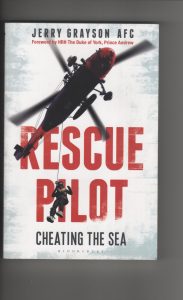- Author
- Book reviewer
- Subjects
- History - general, Book reviews, Royal Navy
- Tags
-
- RAN Ships
- None noted.
- Publication
- June 2015 edition of the Naval Historical Review (all rights reserved)
Rescue Pilot by Jerry Grayson, AFC. Published by Bloomsbury, London, 2015. Softback, 230 pages with photographs. rrp $29.99.

Most boys who want to fly dream of screaming supersonic jet fighters and white knuckle excitement. Jerry Grayson was not in that mould but by the age of 12 had identified what he wanted to do. His high school maths teacher happened to also be interested in aviation and in one report drily remarked: Grayson’s application to the syllabus can be variable; his discourses on three-dimensional air traffic systems are a bit much for me at eight o’clock in the morning. The Navy, however, was apparently impressed with his enthusiasm and marked him while still in school so that in 1972, he walked through the doors of Dartmouth Naval College and by the age of 17 he had become the youngest pilot in the Royal Navy’s history. He had already qualified as a civilian pilot with some assistance from the Navy.
Grayson played a major part in the rescue of many of the survivors of the now infamous 1979 Fastnet Yacht race, which involved some Australians. This awful event claimed the loss of 15 lives when 24 yachts were abandoned and 5 sunk, but 136 lives were saved and it was mostly helicopter crews in Wessex and Sea King machines from RNAS Culdrose who did the job. This part of the book takes two chapters but is highly recommended for anybody not familiar with helicopter rescue at sea in atrocious weather. Here waves were as high as the aircraft hovering 15 or more feet above the troughs, with the gusting wind screaming and the helo downwash complicating the aircraft’s positioning in some semblance of stability without the pilot able to see what is happening below. Grayson ably and clearly describes what this situation but does not grandify himself. He generously describes the important part every member of the crew plays. The Observer is flat-out keeping track of where the aircraft is during a myriad of chaotic manœvers, moving from one place to another and how to get it back home with fuel still in the tank; the Aircrewman has to be the pilot’s eyes and call precise hovering directions that won’t drop the whole show into the angry ocean while the terrifying tasks to be performed by the diver at the end of a cable has one reading fast-forward with bated breath. The media of the time described the occasion as: The most intensive rescue operation in maritime history.This part of the book is an excellent word picture for a layperson while the experienced naval helicopter fraternity will relive every moment with a tense sense of understanding.
Jerry Grayson had also served in normal sea deployments, especially in HMS Ark Royal and by age 25 had become the most decorated pilot in Naval Fleet Air Arm history. This included an Air Force Cross – a rare decoration for any pilot, let alone a naval one.
On completion of eight years naval service Grayson decided to give civilian helicopter operations a try. This was a good choice as it was not long before he established his own company and after a variety of general bread-and-butter jobs began to develop a reputation of being the ‘go-to’ pilot for aerial photographers, TV crews, and movie makers of the ‘Bond’ adventure type, aerial surveyors and suchlike. He developed a knack of instinctively knowing the specialised requirements for this sort of work and increasingly some of it began to grow in Australia, to the extent that he and his wife now live just outside Melbourne.
Interestingly the author dedicated his book to his principal Air Engineer. The foreword was written from Buckingham Palace by HRH Prince Andrew the Duke of York. As any Fleet Air Arm member will know the Prince is well qualified to write such a commendation. This book provides a lively account of a kind of life few experience, written in graphic style, making a highly technical topic easily understood and gripping story.
Reviewed by: Ron Robb




